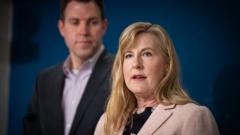A woman lays a flower at a makeshift memorial outside the Minnesota state legislature building. Jessie Ebertz, holding back tears, expressed the state's deep sense of loss following the shooting deaths of Democratic politician Melissa Hortman and her husband, Mark. "Minnesota has felt a little bit like a safe haven," Ebertz, a government employee based in St. Paul, said. "This has blown that out of the water."
The tragic incident, which occurred early on Saturday morning, has left the state in shock. Hortman and her husband were targeted by a man disguised as a police officer. Alongside them, Democratic state lawmaker John Hoffman and his wife were injured but are recovering, marking a stark reminder of how political tensions can escalate into violence.
Suspect Vance Boelter was tracked down after a state-wide manhunt that reflected the urgency and fear surrounding the incident. His actions have raised alarming questions about political motivations behind such attacks, drawing attention to the erosion of trust in Minnesota’s famed culture of politeness.
Some are questioning the notion that Minnesota can remain shielded from national political aggression. Jenna Stocker, editor of Thinking Minnesota, emphasized a growing divide fueled by political agendas, leading to increasing hostility among neighbors. The chilling reality is that violence has been on the rise across the United States, with studies revealing that political violence now reaches levels unseen since the 1970s.
While the attack on various politicians has heightened anxiety, it appears that larger threats of violence surrounding political events have not universally materialized, especially during the aftermath of recent elections. However, the fabric of civility seems frayed, as some incidents of politically motivated violence have been reported in other states, further igniting fears of escalating tensions.
Inside the Capitol, mourners gathered, placing flowers and signs demanding change in the wake of the tragedy. Yet, despite the palpable sense of grief, security measures appeared minimal, raising concerns among the public regarding the protection of their lawmakers.
Amidst this turmoil, national political discourse continues unabated. President Trump publicly criticized Minnesota’s Governor Tim Walz while associates of the former president speculated about Walz’s connections to the tragedy without evidence. The rapid dissemination of conspiracy theories illustrates the fractured landscape of political dialogue.
Boelter's motivations are still unfolding, as evidence suggests he may have sought to target left-leaning politicians. Kameko White, a neighbor, expressed her fears, recounting her daily encounters with the suspect, now under investigation.
While Boelter's capture provides some relief, the community faces a pressing question: How to heal and prevent future incidents? Activists like Stocker call for a generational shift towards rejecting divisive rhetoric and embracing unity, stressing the importance of youth-led movements against violence in politics.





















